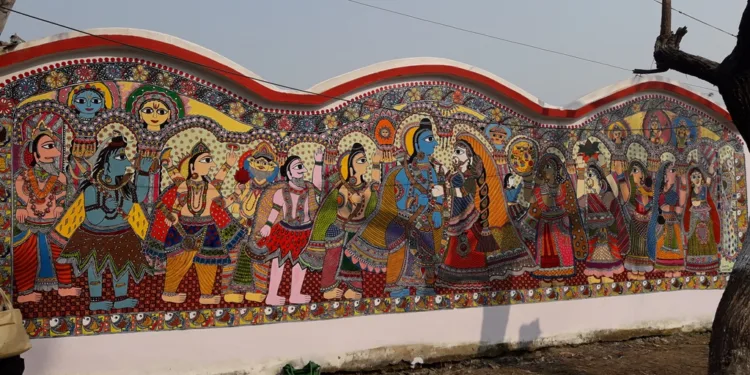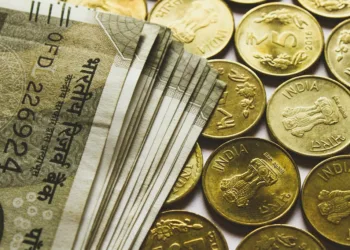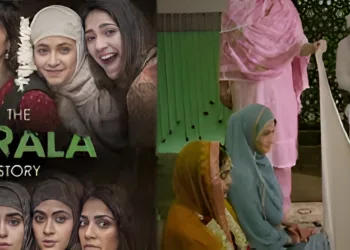A feminist genre of folk art named after Sita
By Ajit Kumar Jha
Mithila is the other name of Sita, the main protagonist of the epic, the Ramayana. Janakpur, named after Sita’s father, the wise King Janak, is widely believed to be her birthplace. The white marble Janaki Devi Mandir, in the city centre of Janakpur, in southern Nepal, is today an important pilgrimage centre. Madhubani is the other name by which Mithila paintings are known. The northern Bihar district of Madhubani
(meaning forest of honey), is considered the heart of Mithila culture and creativity. The Mithila region is divided politically by a porous border between Nepal and India, but unified by the Maithili language, Mithila paintings, history, collective memory and a common Mithila culture. Defined by vivid and vibrant colours, with unique geometric shapes and linear sketches, Madhubani paintings are quintessentially an ancient folk art form that originated in the hamlets of the Mithila region and are named after Goddess Sita.
I grew up in the lap of Mithila paintings as a child. My mother, aunts and most prominently grandmother, the late Gauri Mishra (wife of Dr Bhawanath Mishra), not only painted but made Mithila paintings a popular movement—bringing them to the notice of the world.
Today you can spot bright and beautiful Mithila paintings etched all over the roadside walls of Chajju Bagh (near Gandhi Maidan) in Patna, the railway stations of Madhubani, Darbhanga, Patna and other cities of Bihar. I recall that the Jayanti Janata train, which ran between Patna and Delhi, had Madhubani paintings etched in all the bogies.
Mithila art and International Women’s Day
On the occasion of International Women’s Day this year, the iconic Bihar Museum in Patna is displaying the works of 42 women Mithila painters from the state from March till April.
Seven of these artists are Padma Shri awardees: the late Jagdamba Devi (1975), Sita Devi (1981), Ganga Devi (1984), Mahasundari Devi (2010), Bauwa Devi (2017), Godavari Dutt (2019) and Dulari Devi (2021). Some women artists paint in different styles, using handicrafts as a medium. Tikuli art, Manjusha, Sujni, and papier mache are the other styles.
In the past 60 years, Mithila paintings have become popular with distinctive styles based on sociology and geography. The majority of painters can be identified based on their caste origins and styles. Painters from the Karn Kayastha caste and Scheduled Castes have evolved besides those
from the Brahmin caste. Leading Karn Kayastha painters are Pushpa Kumari (granddaughter of Mahasundari Devi), her sister, Mala Karn, and
brother, Pradyuman Kumar.
Historically, the women of Mithila have painted to decorate the walls of the kohbarghar (nuptial chamber) on the occasion of marriage and the mandap during mundan (tonsuring) and upanayana (sacred thread) ceremonies. Aripan (floor sketches) and Pata Chitra (paper paintings) are the other distinctive styles. Wall, floor, or paper—all are painted with colours extracted from natural plants, including crushed rice, and minerals. Bamboo twigs or a pen and pencil replace a paintbrush.
A folksy feminist genre of art
The kohbarghar paintings tell stories from the Ramayana and Mahabharata, representing tender love between Lord Rama and Sita, Krishna and
Radha, Mahadev and Parvati, and other gods and goddesses. Since Koilakh, Ranti, Mangrauni, Pilakhwar and Sarisau Pahi were important villages
in Madhubani where Tantra Vidya flourished, Mithila paintings visualise Tantric symbolism with emphasis on feminity, challenging traditional patriarchy.
“Traditional Mithila paintings mock patriarchy through the feminine images and symbols as an eminent cosmic power, a source of creation, and
destruction. Tantric images and signs in Mithila paintings shout out the power of femininity, challenging patriarchal beliefs of men as a centre
and women as a margin,” argues art scholar Pragya Paneru.
Mithila has always been culturally rich with home training for women in painting, arts and crafts, sculpture (Sama Chakeba, a mud sculpture game played between brothers and sisters), and singing (Vidyapati songs). Mohan Mishra, a brilliant doctor from Darbhanga Medical College, once wrote: “Each family of Mithila has a daughter who is either a painter, a singer, a sculptor, a dancer, or at times, all of those together.”
A brief history of Mithila paintings
In 1934, the massive Bihar earthquake of 8.0 magnitude shattered lakhs of houses in Bihar and Nepal. William G. Archer, a British officer, discovered folksy Mithila paintings among the ruins. He returned to England with black and white pictures of the Madhubani paintings and in 1949 wrote an article in Marg journal.
Cut to the mid-1960s. Back-to-back droughts in the mid-1960s in poverty-stricken rural districts of Mithilanchal compelled women artists to sell
their paintings to the outside world. The late Pupul Jayakar, then director of the All India Handicrafts Board, sent a Mumbai-based artist, Bhaskar
Kulkarni, to Mithila to encourage the women to make their paintings on paper to enable them to be transported and popularised.
“Bhaskar Kulkarni, who was my dear friend, devoted his entire life to reviving Mithila paintings,” says painter and poet Jatin Das.
Later, art scholars from abroad such as Yves Vequad, Erika Moser, and Raymond Le Owens promoted the Mithila art form internationally. Encouraged by the All India Handicrafts Board, women artists converted the crisis into an opportunity by applying their painting skills to
paper and cloth. Art collectors could thus readily buy and sell the paintings. The creative skills of the Mithila women painters thus became known
globally. Folk art collectors from France, Japan and the United States were the first to buy these paintings.
Tokio Hasegawa, chairman of the NPO society to promote India-Japan Cultural Relations, founded the Mithila Museum in Japan in 1982. The museum, housed in a converted schoolhouse in Tokamachi, Niigata Prefecture, contains approximately 2,000 Mithila artworks, 300 of them
created in Japan.
Savita Jha Khan, who worked with Mithila painters in Niigata Prefecture, points out the extraordinary role played by Hasegawa.
In 2015, the newly-completed Bihar Museum in Patna displayed outstanding works by Mithila painters in its Regional Art Gallery. The Bihar Museum selected the paintings of Vinita Jha, of Ramnagar village in Madhubani, under the category, Utkrisht Mithila Art. In this issue of Pravasi
Indians, to mark Women’s Day, we have carried some of Vinita’s sublime paintings and articles on the gender divide and the feminist movement: in English and in Hindi. The articles and the Mithila paintings add a new dimension to feminism and the celebration of International Women’s Day on March 8.








